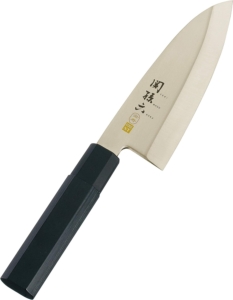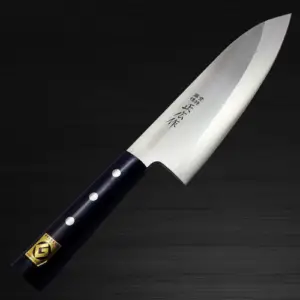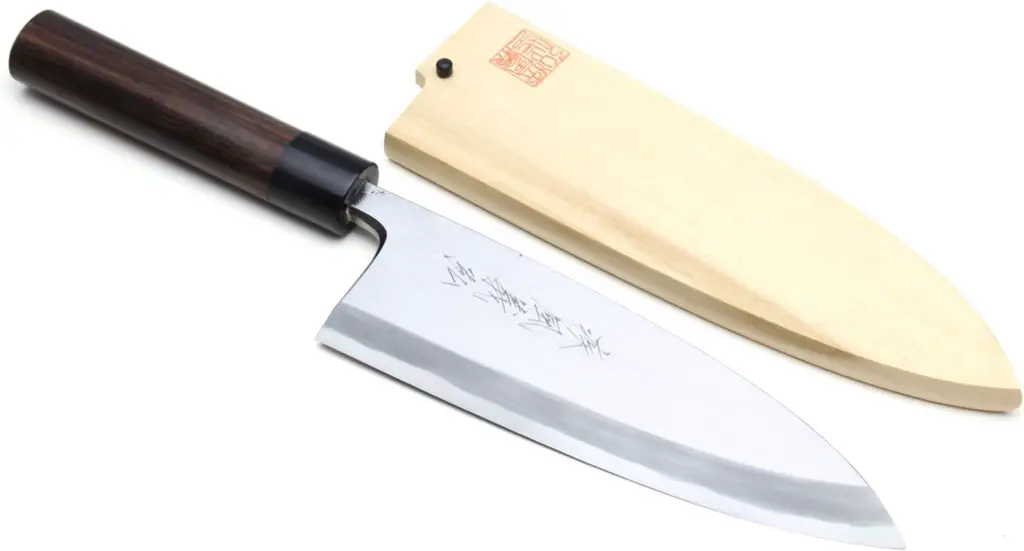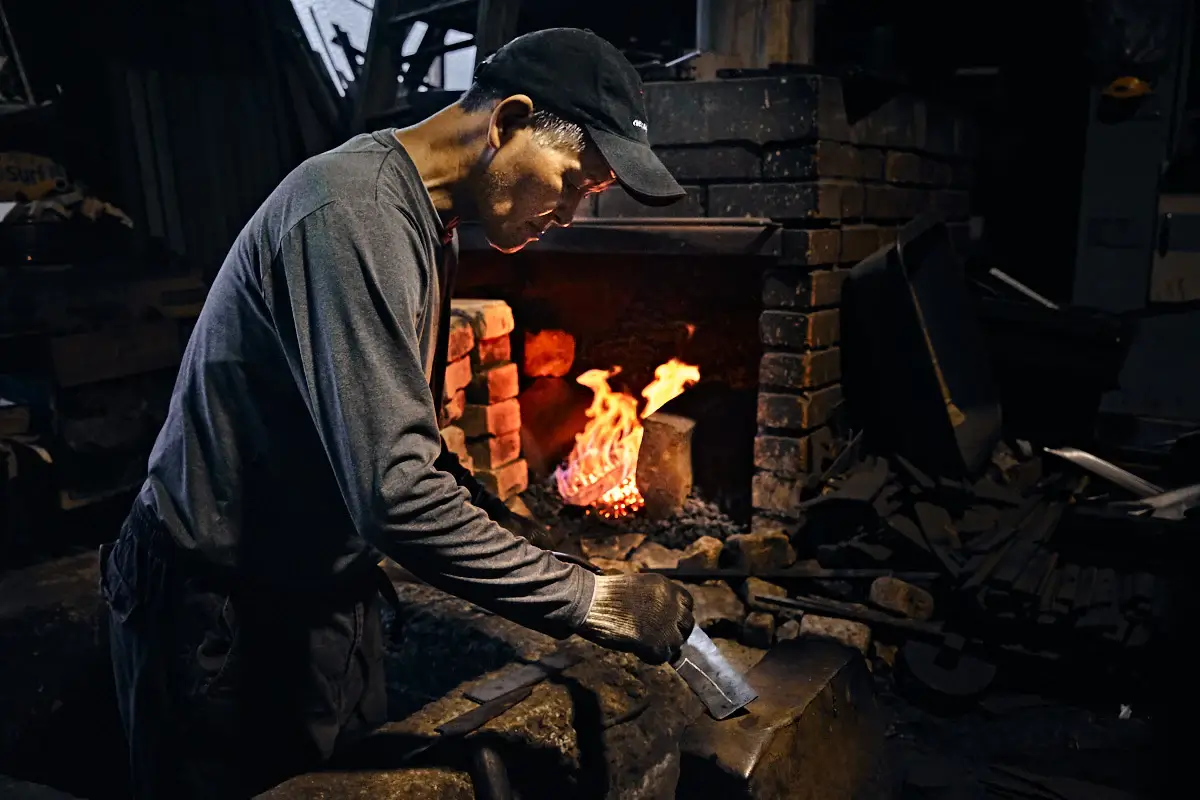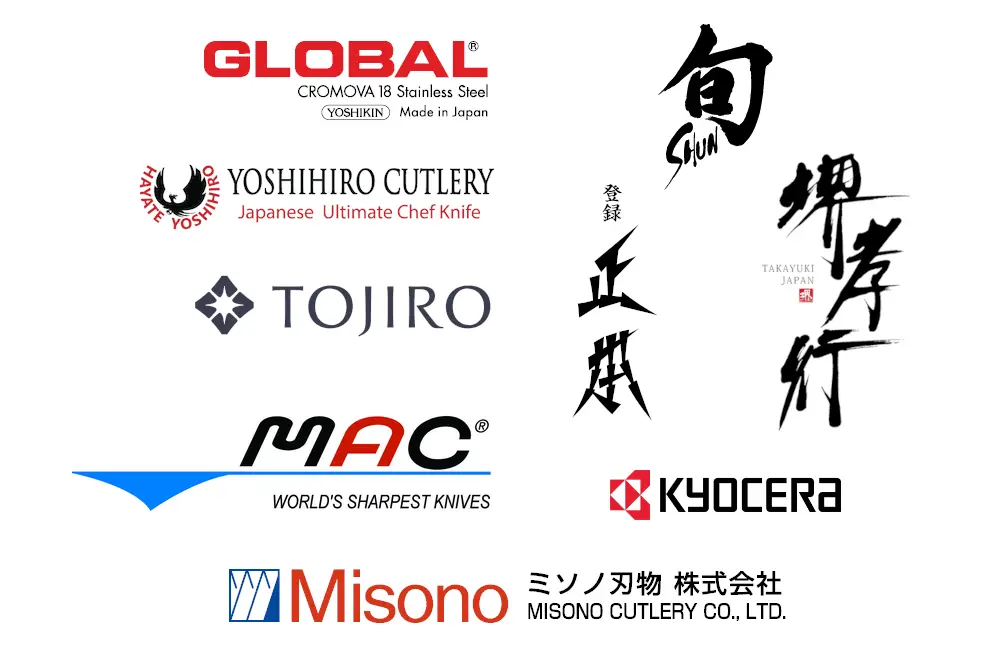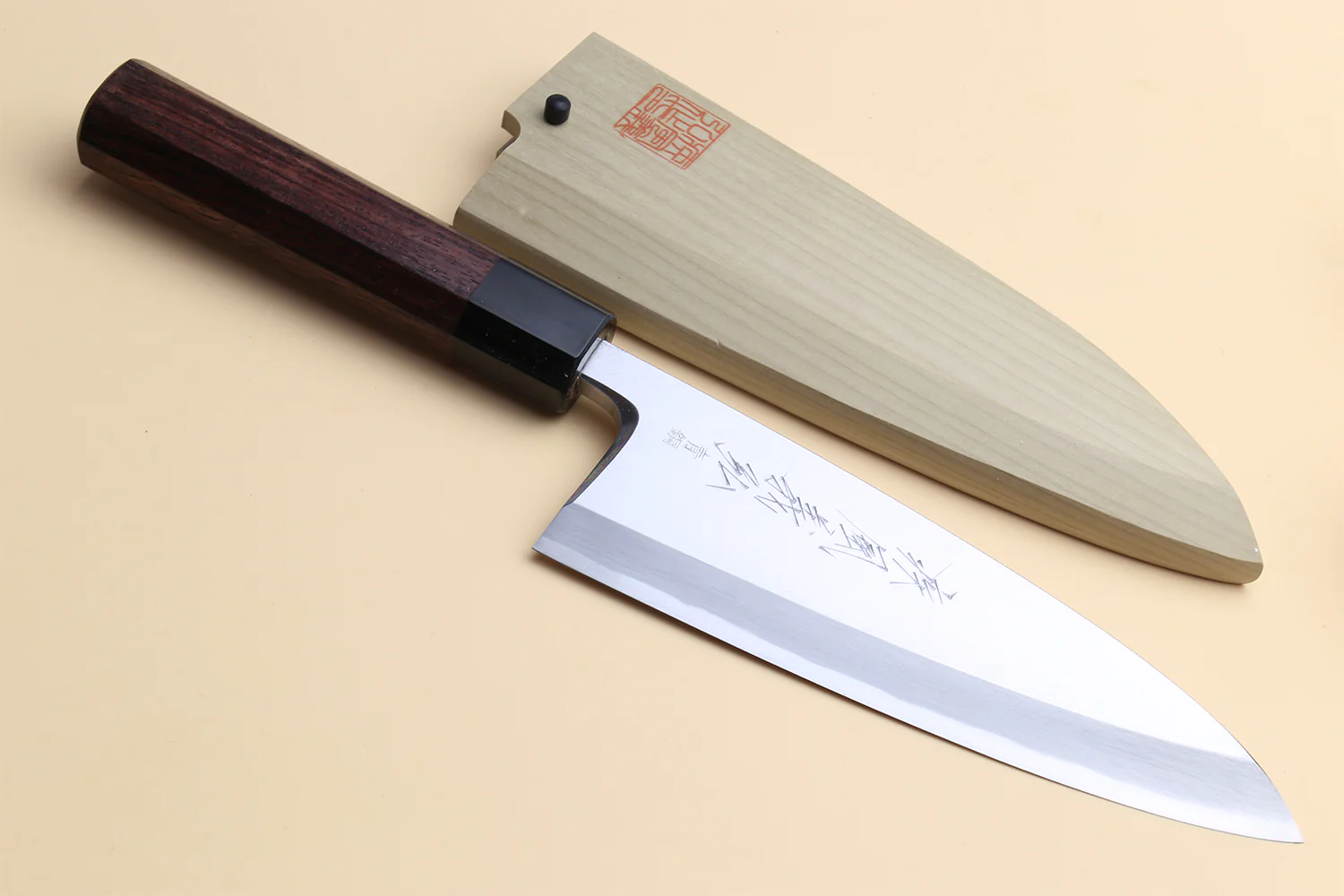
Deba (出刃) is a traditional Japanese knife whose primary purpose is to cut and fillet whole fish.
Some chefs also use a deba for breaking down chicken or poultry.
A deba is one of the three most important traditional Japanese knife types, along with yanagiba and usuba.
In this post, I take a look at five of the best deba knives available for every budget. If you’re in a rush, here are my top picks:
- Budget choice: Kai Seki Magoroku Deba ($45)
- Value choice: Masahiro Stainless Deba Knife ($89)
- Premium choice: Sakai Takayuki Kasumitogi White Steel Deba ($99)
- Super premium choice: Yoshihiro Shiroko Kasumi Deba ($255)
- Ultra premium choice: Yoshihiro Honkasumi Blue Steel Deba ($400)
Read on for detailed descriptions of each knife, as well as more useful info about deba knives.
Let’s get chopping (or filleting)!
Disclaimer: The Chef Dojo may receive a small commission if you decide to purchase products links on this page. It helps to support the website. Thanks!
Best Deba Knife Recommendations
First, here is a quick table of all the knives on this list. It includes the knife brand, blade length(s), steel type, and approximate price (for 165mm version).
Each of these knives are easily purchasable on online stores like Amazon or Hocho Knife. Just click the “buy here” link in the table.
| Name | Steel | Blade Length(s) | Price | Check latest Price | |
|---|---|---|---|---|---|
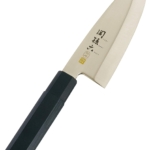 | Kai Seki Magoroku Deba | MV Stainless | 105mm; 150mm; 165mm; 180mm | $ | on Amazon |
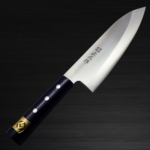 | Masahiro Stainless Deba | MV Stainless | 120mm; 135mm; 150mm; 165mm; 180mm; 210mm | $$ | on Hocho Knife |
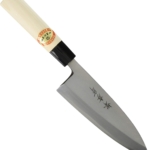 | Sakai Takayuki Kasumitogi Deba | White Steel No. 3 | 90mm; 105mm; 120mm; 135mm; 150mm; 165mm; 180mm; 195mm; 210mm; 225mm; 240mm; 270mm; 300mm | $$ | on Amazon |
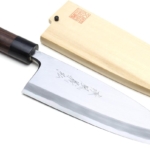 | Yoshihiro Shiroko Kasumi Deba | White Steel No. 2 | 150mm, 165mm, 180mm | $$$ | on Amazon |
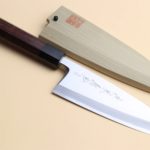 | Yoshihiro Honkasumi Blue Steel | Blue Steel No. 2 | 165mm, 180mm | $$$$ | on Amazon |
Best Budget Deba:
Kai Seki Magoroku Deba
Best budget deba knife
- Cheap price;
- Multiple blade lengths available
- Reliable brand
- Price (at time of publish): $39
Description
Kai is one of the largest knife companies in Japan, and also makes the popular “Shun” knife brand.
If you’re looking to try your first deba knife, or just on a tight budget, then the Seki Magoroku Deba Kinju is an excellent choice.
The blade is made with a Molybdenum Vanadium (MV) stainless steel, which is very sharp out of the box and easy to maintain. Despite being considered “stainless”, it is still recommended to hand dry the blade after use to prevent premature rusting.
The knife is very lightweight, which makes it easy to handle. This could also be a downside depending on your purpose. It may not have enough “heft” to break down larger fish. For small jobs, it should be fine though.
The knife only costs $45 to $60 (depending on blade length), so definitely will not break the bank. It is the cheapest option on this list, and recommended for beginners that want to try out a deba.
Key Specifications:
- Steel: Molybdenum Vanadium stainless steel
- Blade Length(s): 105mm; 150mm; 165mm; 180mm
- Weight(s): 103g; 246g; 289g; 317g
- Handle: Octagonal; made with laminated wood
Note: For a similar knife with round handle, check out this version
Great value:
Masahiro Stainless Deba Knife
Best value deba knife
- Excellent value
- Highly reputable brand
- Durable; “Good Design” award
- Price (at time of publish): $89
Description
Masahiro is one of the most reputable knife brands in Japan.
This particular deba is part of Masahiro’s budget friendly lines called the “Stainless Steel Japanese Knives” (ステンレス和包丁). It won the “Good Design” award in Japan.
It is made with Masahiro’s own proprietary stainless steel called MBS-26, which is basically a Molybdenum Vanadium steel.
This knife has very high quality construction, and is durable enough for professional use.
The knife also comes in a huge range of sizes (120mm to 210mm blade lengths), so you can be sure to find one (or two) that fits your needs.
It is value-priced, with a range from around $60 to $135, depending on size.
If you want a step up from the entry-level Kai Seki Magoroku (listed above), but still want the convenience of stainless steel, then this Masahiro deba is a great choice.
Premium Choice:
Sakai Takayuki Kasumitogi White Steel Deba
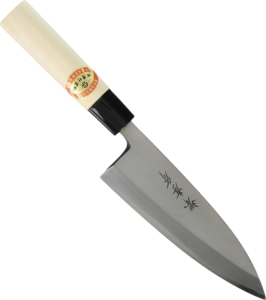
Professional’s choice
Sakai Takayuki Kasumitogi Deba
- Premium steel type (white steel)
- Highly reputable brand
- Professional use
- Price (at time of publish): $99
Description
Sakai Takayuki is another highly respected knife brand in Japan.
This deba’s single-bevel blade uses white steel no.3 (i.e. shiroko #3). It is considered a very pure high carbon steel typically only used for professional chefs.
The blade takes and holds an edge extremely well, but requires proper care and maintenance to prevent rusting. It is generally not recommended for beginners to use this kind of steel.
The knife also comes in a huge spectrum of blade sizes — from 90mm all the way up to 300mm. Chefs use different length knives depending on the size of the fish.
If you know what you’re doing, then the Sakai Takayuki Kasumitogi Deba is a great knife.
Prices range from around $80 up to over $600! If you are going for the 165mm version, it is cheaper to buy on Amazon.
Key Specifications:
- Steel: White Steel No. 3
- Blade type: Single bevel
- Blade Length(s): 90mm; 105mm; 120mm; 135mm; 150mm; 165mm; 180mm; 195mm; 210mm; 225mm; 240mm; 270mm; 300mm
- Weight(s): 131g; 183g; 217g; 225g; 275g; 412g
- Handle: U-shaped; Magnolia wood
For other blade lengths, go to Hocho Knife
Super Premium:
Yoshihiro Shiroko Kasumi Deba
Best super premium deba
- White Steel No. 2 (HRC 62-63)
- Ultra sharp; excellent heft/weight
- Includes blade cover (i.e. saya)
- Price (at time of publish): $255
Description
This super premium choice for Yoshihiro is made with White Steel No.2, and uses kasumi forging technique.
Kasumi involves using the hard steel (i.e. white steel #2) for the cutting edge, and softer iron for other parts of the blade. This allows the knife to have excellent cutting performance, but more durability than if the blade was made completely of the hard steel.
The downside is that there could be warping since there are different steels used on the front/back of the blade. You just need to ensure the knife maker you buy from is reputable and knows what they’re doing.
This knife from Yoshihiro should have no warping problems, as it is made by excellent craftsmen, and already has many positive customer reviews.
The main downside, of course, is the cost. Prices range from around $230 to $300, depending on size.
Key Specifications:
- Steel: White Steel No. 2 (HRC 62)
- Blade type: Single bevel
- Blade Length(s): 150mm, 165mm, 180mm
- Handle: Round shape; Magnolia wood
Ultra Premium:
Yoshihiro Honkasumi Blue Steel Deba
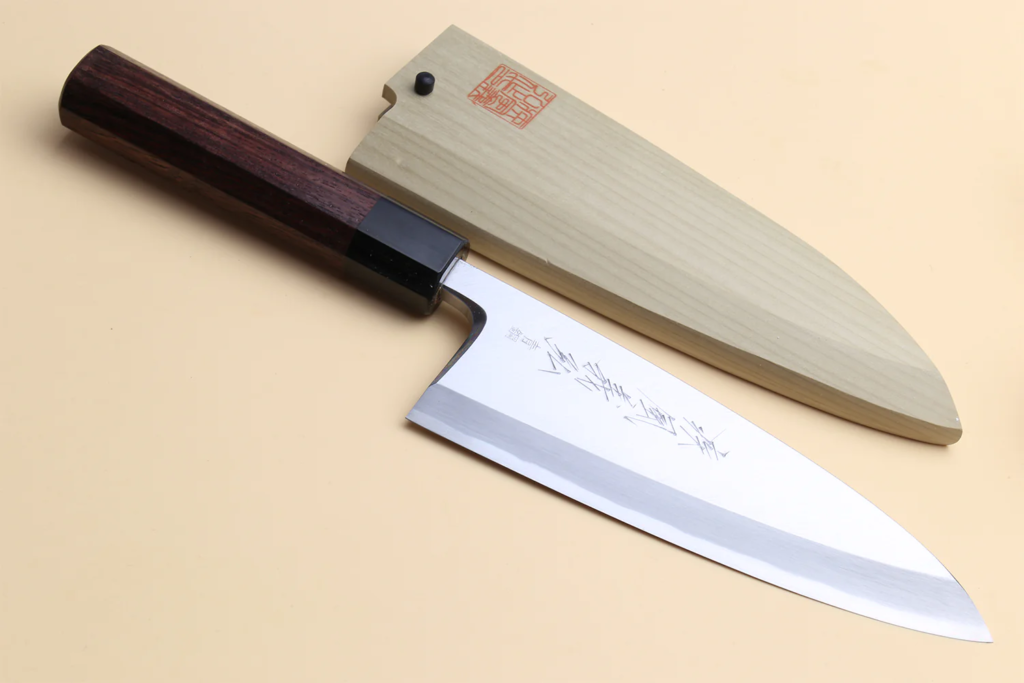
Show-off 😎
Yoshihiro Honkasumi Blue Steel
- Blue Steel No. 2 (HRC 63-63)
- Hon-kasumi forging
- Includes blade cover (i.e. saya)
- Price (at time of publish): $400
Description
Budget is of no concern?
Then check out this super ultra premium, blue steel, honkasumi forged deba from Yoshihiro.
Compared to the white steel knife above, blue steel is harder (HRC 63-64), has better corrosion resistance and edge retention. It is more difficult to sharpen though, so make sure you know what you’re doing, or send it to a professional to sharpen.
Honkasumi (or hongasumi) is like an upgraded version of the normal kasumi explained above. It typically involves some extra refining steps, and a higher-end finish.
The only downside of this knife is that it costs $400 (for 165mm version). If you can afford it, then please buy one for me too 😂
Key Specifications:
- Steel: Blue Steel No. 2 (HRC 63-64)
- Blade type: Single bevel
- Blade Length(s): 165mm, 180mm,
- Handle: Octagonal shape; Rosewood
Deba Knife Types & Variations
There are actually many different deba types and variations. Each type has slightly different blade size and/or thickness for dealing with different types of fish. Let’s look at a few common deba variations:
Yo-Deba (洋出刃)
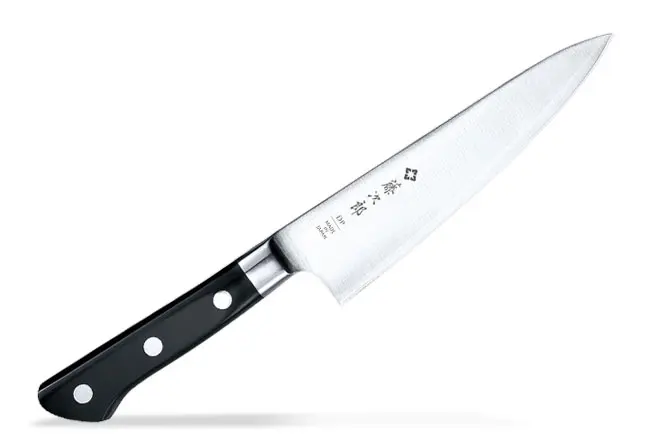
A yo-deba simply refers to a Western-style deba knife (“yo” means Western style). It features a Western-style handle, and double-bevel blade. A yo-deba is heavier/stronger than a classic deba, so it is suitable for rougher tasks like butchering lobsters, crabs, chickens, or other tough ingredients.
Ai-Deba (相出刃包丁)
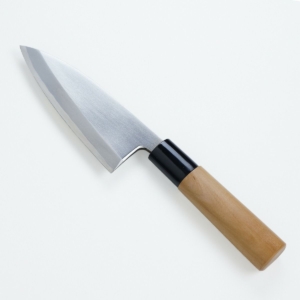
An ai-deba refers to a deba with a thinner blade. The thinner blade makes it easier to make precise cuts, but unsuitable for cutting through fish bones compared to a standard deba. Sometimes, it is also used to quickly slice fillets into sashimi, instead of using a yanagiba.
Ko-Deba (小出刃)
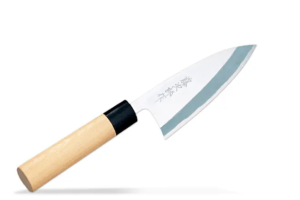
Ko-deba literally translates to “small” deba. It is exactly the same as a standard deba, but specifically used for handling smaller fish. A ko-deba ranges in size from around 90mm – 135mm.
Aji-Kiri (あじ切)/ Aji-Deba (あじ出刃)
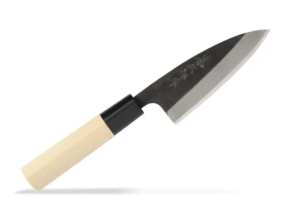
Aji-deba is a small sized deba similar to a ko-deba, but with a thinner blade. It was designed and named for dealing with small fish like horse mackerel (called “aji” in Japanese).
Mioroshi Deba (身卸出刃)
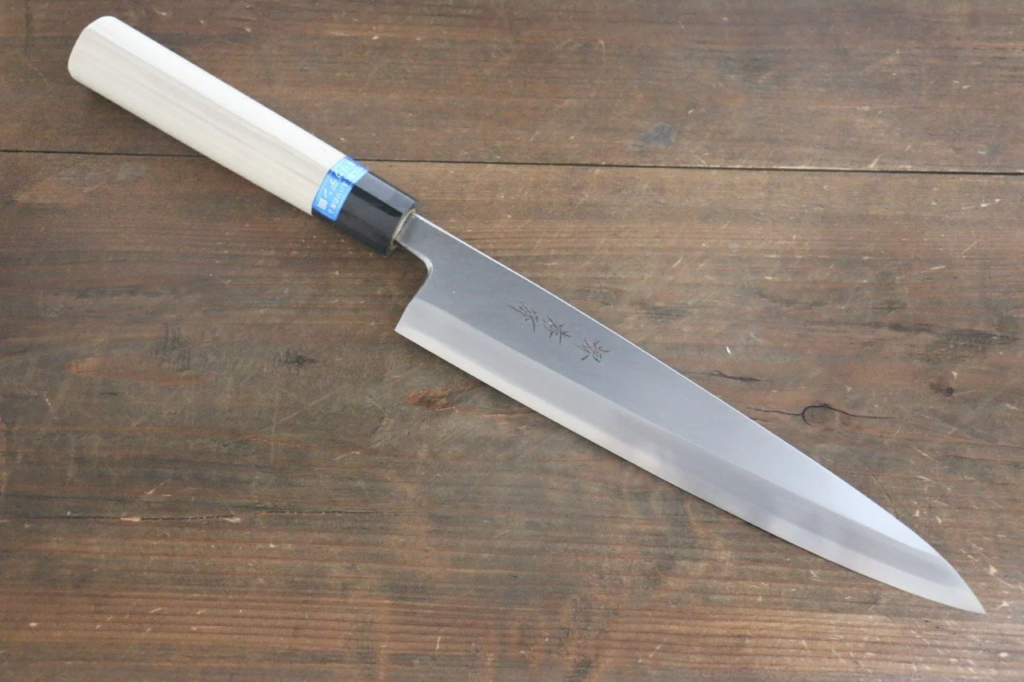
The mioroshi deba is a cross between a yanagiba and deba. It can be used for filleting a fish, and also slicing the fillet into sashimi pieces. The blade is more delicate than a standard deba, so should not be used for cutting through fish bones.
👉 Click here to see more Japanese knife types
How do I choose a Deba knife?
Here are a few things you should consider when choosing a deba knife:
1. Size & Blade Length
The first thing you should consider is the size/length of the blade. This mainly depends on what type/size of fish you plan to prep with your deba. A larger fish will need a larger blade size. A smaller fish will require a smaller/thinner blade.
Professional chefs typically have multiple types of deba knives. For home use, a deba blade size around 150mm to 165mm (6″ to 6.5″) is probably suitable for most cases.
2. Steel Type
The next thing to consider is the steel type.
Stainless steel is easier to maintain, and usually the recommended option for home cooks.
High carbon steel (like White Steel or Blue Steel) offers better cutting performance, but is difficult to maintain. It is typically reserved for professional chefs or enthusiasts.
Click here for more info on Japanese knife steel types
3. Handle Type
Handle type is more of personal preference. Most deba knives comes with a traditional Japanese style handle (unless you get a yo-deba). Traditional handles are either round, octagonal, or D-shaped. Pick whatever feels best to you.
4. Brand / Maker
Always buy from a reputable Japanese brand or knife maker. There’s a lot crappy sellers out there these days, especially on sites like Amazon or other marketplaces.
All the knives listed here are legit, high quality Japanese knives. If you find another knife that you like, you can cross reference the brand/maker with this list of authentic Japanese knife brands.
Other Deba FAQ
Can deba cut through bone?
Yes, a standard deba is meant to cut through fish bone.
Do not use it to cut through thick beef or pork bones, as you will probably damage the blade.
Can I use a deba knife for meat?
Yes, technically you can use a deba knife for meat, although it may not be the best choice.
If you are butchering meats, you may want to consider a sujihiki for separating meat from bones, or a heavy cleaver for breaking down large pieces.
Can you use a deba knife for everything?
Yes, technically you can use a deba knife for everything, although that is not its design. A deba is specifically designed for filleting fish.
If you want an all purpose kitchen knife, you should consider a gyuto or santoku.
Is deba single or double bevel?
Most deba knives are single bevel. You can find the odd one that has a double bevel blade.
Yo-deba (i.e. Western style deba) variations will typically have double bevel blades.
What does deba mean in Japanese?
Deba (出刃)literally translates to something like “pointed blade”.
Why is a deba so thick?
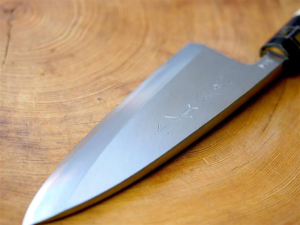
A standard deba knife has very thick spine (see image above), and heavy weight compared to all-purpose kitchen knives like gyuto or santoku.
The heavier, thicker blade is designed to make it easier to cut through the bones and head of a fish.
Summary
A deba is a specialist knife meant for breaking down and filleting fish. The best deba knife for you depends on your own needs and budget.
For beginners looking for a budget-friendly choice, the Kai Seki Magoroku is a nice entry-level option.
For a step up, the Masahiro Stainless Deba offers excellent value and easy maintenance for home users. It is also durable enough for professional use.
If you’re already a pro, then check out the Sakai Takayuki Kasumitogi which uses premium White Steel.
If money is no concern, then check out super premium Yoshihiro Shiroko Kasumi Deba or Yoshihiro Honkasumi Blue Steel Deba.
Let me know in the comments:
Which of these deba knives did you buy? Did I miss one on my list?
Drop a comment below to let me know.
Subscribe for free today! Receive cool recipes, my latest Japanese knife picks and learn about Japanese culture. Delivered every other week to your inbox.
